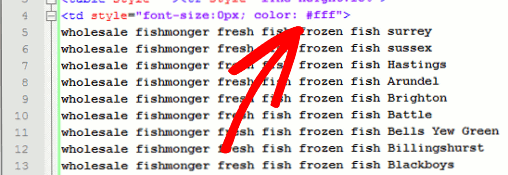Maintaining a high SERP ranking requires staying current with SEO trends and adapting your strategy to suit any new algorithm updates.
However, some websites are trying to outsmart search engines to drive organic traffic to their websites by breaking the rules. These practices are against Google’s terms of service can lead to your website’s removal from Google’s indexes and affiliate sites.
This article will teach you:
- Black Hat SEO tactics and techniques
- How to report Black Hat SEO
- How black hat SEO impacts your website
What is Black Hat SEO
Black hat SEO is a set of techniques for improving a site’s or page’s search engine ranking by circumventing search engines’ terms of service. The term “black hat” was coined to distinguish “bad practices” from “good practices” who wore white hats (see white hat SEO). We commonly use it to describe computer hackers, virus developers, and people who engage in unethical tech practices.
Grey Hat SEO
If you can’t decide whether an SEO tactic is black or white, it’s most likely a grey hat technique.
What is Grey Hat SEO?
Grey hat SEO refers to SEO techniques that are a little shady. While they do not violate Google’s best practices, they could be unethical and may be banned in the future.
This practice straddles the line between black hat and white hat SEO. While grey hat tactics aren’t usually listed as prohibited practices in webmaster guidelines, they remain suspect. Many old grey hat tactics have evolved into black hat tactics as search engines keep updating their algorithms.
Black Hat techniques in SEO
Keyword Stuffing
Keyword stuffing is the practice of overusing target keywords into your content to manipulate SERP rankings. Users will have a negative experience if you use multiple variations of keywords that add no value.

For a website offering free music downloads, here’s an example of keyword stuffing:
“We offer free music downloads. We specialize in free music downloads. Contact one of our music consultants if you’re thinking about getting paid high-quality music for download.”
That sounds like a broken record. It’s pretty obvious, and Google will pick up that the content doesn’t sound natural.
You can conduct keyword research to learn what people are looking for, but overusing these terms in your content is not recommended. Rather than stuffing your content with meaningless keywords, focus on creating useful content that emphasizes topics over keywords.
1. Cloaking
Cloaking involves showing users one piece of content while search engines see a different piece of content. Websites that use black hat SEO will do this to get their content to rank for various terms that have nothing to do with their content. Spam websites frequently do this to avoid a search engine bot discovering the spam content they serve to users.
It’s acceptable to tailor your content to different user groups. When someone visits your website from a mobile device, for example, you might reduce the size of your website. You can also change a page’s language based on the country from which someone is visiting. As long as you aren’t simply changing the content that is visible to search engine crawlers.
If you want to see how Google sees your website, you can use the Google fetch tool and compare the results to what users see.
2. Hidden redirects
A redirect sends users to a different webpage when they click on a URL. Redirects are often used outside of their intended purpose in black hat SEO. This practice could include redirecting a search engine crawler to one page. At the same time, all other users are directed to another webpage.
Another example is redirecting a highly authoritative page with many backlinks to a completely unrelated page to improve its ranking in search results. The majority of authority is transferred from one page to another using a 301 redirect. This means that a black hat SEO practitioner could use redirects solely to manipulate search results.
Use redirects only for the purpose for which they were created. For example, when you change your website’s domain or combine two pieces of content on one webpage. In some cases, using JavaScript to redirect users is acceptable.
3. Poor & duplicate content
This practice involves using bots to scrape content from another website. Before 2011, Search engines like Google had trouble detecting plagiarized content. However, Google Panda update fixed this problem in 2011. Many sites with duplicate content saw a drop in search rankings almost immediately. Since then, Google has improved its duplicate and low-quality content detection.
4. Hidden keywords
It’s also against Google’s guidelines to use invisible keywords in your content. Some black hat SEO websites make the text the same color as the web page’s background. This means that the page could show up in search results for those hidden keywords, even if there’s no visible content on the page about them.

When users click on a result, expecting it to be about the topic they searched for, they won’t find the same content they saw on SERP. Why? Because the keywords are hidden.
The “bait and switch” black hat technique involves creating content related to a keyword you want to rank for. Then once the page ranks high, the content is changed to something else entirely. This gives searchers a negative experience because the content they clicked through to see is no longer available. These tactics deceive users and search engines, and they are not an effective SEO strategy.
5. Fake structured data/rich snippets
Rich snippets like review schemas alter your website’s appearance on search engine results pages. It makes your content stand out from your competitors and gives you more space on the SERPs. Pages containing a podcast, recipe, or book can have structured data added to them, among other products and services.
To deceive search engines and users, black hat SEO involves providing inaccurate information in structured data. For example, they might give themselves five stars on a fake review site and add structured data to make themselves stand out on search results pages. Because search engines like Google encourage users to report websites that misuse structured data, this is a very risky practice.
6. Blog comment spam
This black hat technique involves spamming your website links in blog comments, for example, putting your links in hundreds of unrelated Quora questions. Google updated its algorithm to discount any links in blog comments, so this practice is becoming less common. By default, most authoritative blogs make links in blog comments nofollow.
Even though the number of people who spam blog comments is declining, there are still contractors on Fiverr offering blog spam services.
If you run a publication, forum, or community that allows comments, you must take steps to keep bots and spammers out. Google demotes or removes spammy pages from search results. You can reduce the risk of spam by using anti-spam tools like Google’s free reCAPTCHA.
7. Link farms
A link farm is a website or a group of websites that have been created solely to build links. Each website includes a link to the site or sites that they want to rank higher in search results. Search engines rank websites based on various factors, including the number of links pointing to them. Black hat SEO takes advantage of this by using link farms to inflate the number of backlinks a site has artificially.
Link farms are known for having low-quality content and a large number of links. In most cases, the anchor text of the links includes the keyword they want the site to rank for.
8. Private blog networks
A private blog network (PBN) is a collection of authoritative websites used to build links. They’re similar to link farms in that they both try to inflate the number of links pointing to a particular website. Each PBN site links to the site it wants to rank higher in the search results, but not to each other.
When Black hat SEO specialists want to build a private network, they usually buy expired domains with a lot of authority. Then add links to their own site and write content similar to what was on the domain before it expired. They hope that search engines won’t notice they’re running a network of websites and will instead give their main site a higher ranking in the search results.
PBNs have become increasingly difficult to detect by search engines, and if you use them to boost your search visibility, you could face a severe penalty.
Other black hat SEO techniques
- Automated Content
- Competitor Reporting (or Negative SEO)
- Spinning Articles
- Creating duplicate content on pages, subdomains, or domains
The risks of Black Hat SEO
Using black hat SEO tactics to rank your website carries significant risks, which is why most SEOs avoid it. The vast majority of SEO professionals consider these tactics to be completely unethical.
However, the reality is that there will always be a small percentage of marketers who try to game the system to hasten their site’s organic success. Even if black hat SEO techniques work for your website, the results are frequently fleeting.
When it comes to employing black hat techniques, the fact is that they do not benefit users and would not be used if search engines did not exist.
Three reasons to stay away from Black Hat SEO
If a website uses black hat SEO to rank, what are the worst-case scenarios?
Looking deeper into Google’s Webmaster Guidelines, we can see that such violations “may result in a site being removed entirely from the Google index or otherwise affected by an algorithmic or manual spam action,” according to the guidelines. “If a site has been affected by a spam action,” the guidelines continue, “it may no longer show up in results on Google.com or any of Google’s partner sites.”
While the goal of SEO is to increase a website’s organic visibility and traffic, black hat tactics can have the opposite effect.
- It may harm your search engine rankings and visibility.
The main reason to avoid black hat SEO tactics is that it’ll force your website to lose search rankings, visibility, and traffic.
When a website’s traffic and visibility decreases, conversions and revenue typically decrease as well. At best, a significant drop in organic traffic will require a higher investment in PPC or other paid media to compensate.
- It isn’t going to produce long-term results.
Even when manipulative techniques initially improve rankings and organic performance, these gains are rarely sustainable. It may take some time for Google to determine that a website engages in black hat SEO practices (from a manual review or a core algorithm update), but they’ll find out.
The only thing worse than not being able to rank at all is seeing your ranks and traffic plummet. Businesses require predictability, which black hat SEO tactics cannot provide.
- It leads to a negative user experience.
“One thing that became clearer. Google is not necessarily trying to rank sites that had done the best SEO, but rather sites that provided a good or at least acceptable user experience.”
— Bastian Grimm
SEO must consider ease-of-use and strive to provide the best content and user experience possible. On the other hand, Black hat tactics optimize for search engines (or at least what they believe search engines want to see), not for users.
What is the best way to report Black Hat SEO?
While reading this guide, you may have asked yourself the following question:
What if you notice one of your competitors employing black hat tactics, but they aren’t being punished?
When you believe a website is ranking because of paid links, bot traffic, or other violations, you can file a spam report with Google. While reporting a site will not result in immediate action, you will be helping to improve algorithmic spam detection.
It’s frustrating as a publisher to find out that a website is cheating the system and getting away with it. While Google is getting better at preventing such sites from ranking in the top spots on the SERPs, there are still sites performing well with black hat tactics.
Depending on the severity of the webspam that other sites use, there’s a good chance that they’ll be negatively impacted after another algorithm update in the future.
If your website is the target of a spammy link-based campaign, use Google Webmaster Tools’ Disavow Links Tool. Then contact the webmasters who are pointing these links to your site to have them deleted.
While Black hat SEO is no longer as popular as it was, some SEO specialists still practice it. Sometimes they mislead unsuspecting business owners into believing that black hat SEO practices are ethical. When in reality, their techniques are clear violations of Google’s guidelines.
Overall, we advise against using black hat techniques on your website. If you want to improve the visibility of your website online, learn how to rank it using techniques that don’t violate Google’s Webmaster Guidelines.

